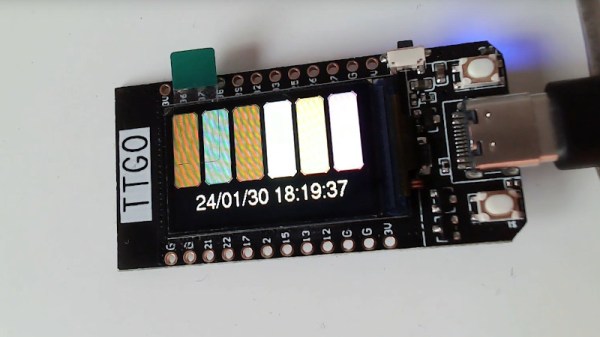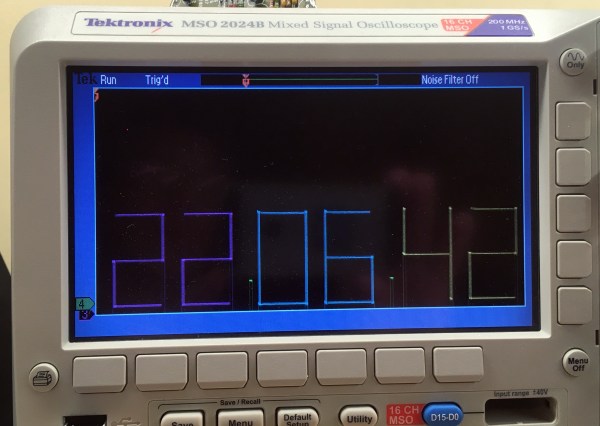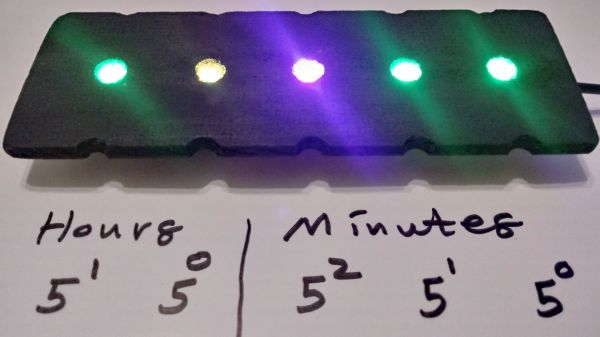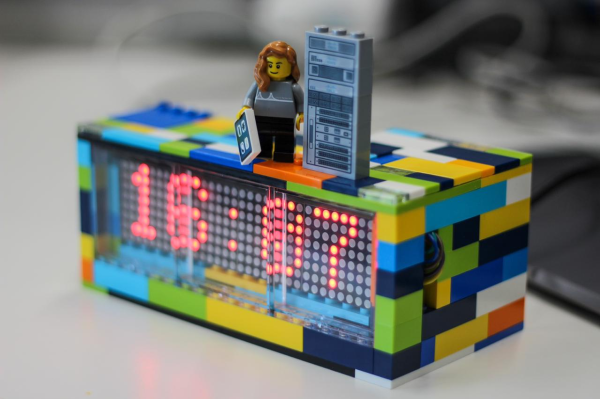
Resistor Color Code Clock Is A Bit Of Fun
Younger electronic engineers may see resistors with old-style color codes to display their values a little less than those from previous years, but if there’s a shibboleth among those who wield a soldering iron it’s probably something similar to instinctively saying “1K” when asked “Brown-black-red?”. Colors as numbers can be used outside resistors, for example in a clock, as [Det Builds Stuff] shows us with an ESP32 TFT dev board.
It’s fair to say that this is more of a software project than a hardware one, but that’s not necessarily a bad thing as he takes us though the process of creating a Network Time Protocol (NTP) capable clock with the dev board. He claims it may be the world’s first resistor clock, something we’d have to disagree with, but beside that we can see this could make a neat little desk ornament with a 3D printed case.
Oddly though, we’d expect older engineers to face the same steep learning curve as younger ones when reading it, because it’s easier to recognize visual sequences of numbers as preferred resistor values than it is to visually decode each one every time.
Continue reading “Resistor Color Code Clock Is A Bit Of Fun”
Pingo Is An Analog Clock That Uses Colors Instead Of Hands
The purpose of a clock is to show the time, obviously. But if you’ve followed Hackaday for some time, you’ll know there are about a million different ways of achieving this. [illusionmanager] added yet another method in his Pingo Color Clock, which, as the name suggests, uses color as the main indicator.
The clock’s face is divided into three concentric circular zones. The zone at the center shows the hours, while the outer ring indicates the minutes. Both change their color such that they match the zone in between, which always shows a complete rainbow, at the desired location. In the picture above for example, the magenta inner circle matches the rainbow at the 10 o’clock position, while the yellow outer circle matches it at 10 minutes past the hour, meaning it’s currently 10:10.
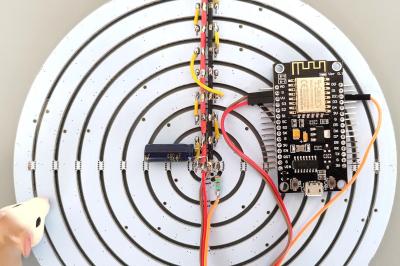 The rainbow ring is also moving however, and by adjusting its rotation through time you can get some interesting effects. [illusionmanager] programmed it in such a way that the outer ring is always yellow during the day, purple at night, and red at sunrise and sunset. The overall brightness is also adjusted to a day/night schedule.
The rainbow ring is also moving however, and by adjusting its rotation through time you can get some interesting effects. [illusionmanager] programmed it in such a way that the outer ring is always yellow during the day, purple at night, and red at sunrise and sunset. The overall brightness is also adjusted to a day/night schedule.
As complex as the clock’s appearance may be, inside it’s quite a simple design. Nine concentric circular LED strips are driven by an ESP8266, which retrieves the time and sunrise information through its WiFi connection. A piece of translucent white acrylic acts as a diffuser, while a 3D-printed enclosure holds everything together.
Encoding the time using different colors of light has been done before in various different ways, and while we haven’t seen Pingo in real life, we believe it should be somewhat easier to read than most of those examples. It might actually form a nice complement to a recent analog LED ring clock.
Continue reading “Pingo Is An Analog Clock That Uses Colors Instead Of Hands”
Oscilloscope Clocks: Now In Color!
Ordinarily, when we hear the words “clock” and “oscilloscope” in the same sentence we conjure images of measuring a stable, repeating square wave that acts as the heartbeat of a system. Of course, that’s not the only meaning– there’s a much more fun and less useful one: using an oscilloscope to display the time.
That’s what [Wolfgang Friedrich] set out to do when he cobbled some protoboard, probes, and an FPGA into the Multi Color Oscilloscope Clock. Each digit on the clock is treated like a seven-segment display, made up of three horizontal bars and four vertical bars. The horizontal bars are generated by constant voltage at different levels, and the vertical bars are generated by quickly switching between two voltages. [Wolfgang] decided to use an R-2R resistor ladder DAC to create the appropriate analog signals from the FPGA’s digital outputs. For bonus points, each set of digits (hours, minutes, and seconds) are output concurrently through separate channels, so they can be displayed in different colors on the screen of his four-channel scope (the fourth channel is used for the points between numbers).
Misusing oscilloscopes in the name of fun has become a time-honored tradition– from Tennis for Two back in 1958 (which later became the beloved Pong) to the plethora of analog o-scope clocks we’ve seen, it’s clear that hackers just can’t get enough of the unique vector display style that a scope can provide. We love [Wolfgang]’s idea of using the scope’s channels to create a multi-color display, and we’re left wondering what kind of wacky waveforms we’ll be seeing next.
Colorful Quinary Clock Makes The Most Out Of Five Neopixels
If binary digits are bits, are quinary digits “quits”? Perhaps, but whatever you call them, you’re going to have to wrap your head around some new concepts in order to make sense of this quinary display clock.
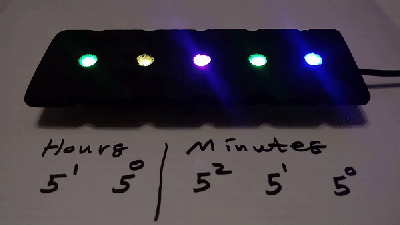
Why quinary? [Spike Snell] wanted to minimize the number of LEDs, and 52 is enough to cover all 24 hours. Binary clocks may have geek chic, but there are only so many ways to display ones and zeros.
[Spike]’s clock is unique because it shows each quit using a single WS2812 Neopixel. The values zero through four are each represented by a different color, meaning the user needs to memorize which color goes with which value, which we suspect is the hardest part of learning this clock. The clock’s software is fairly simple and runs on an ESP8266, and uses NTP to keep on track. The clock self-adjusts for Daylight Savings time, and it has a nice feature that dims the display in the evening to make living with it easier.
Even for those not up on their base-five arithmetic, [Spike]’s clock is still a nice, slowly evolving abstract art piece. And for those who grok the quinary clock, perhaps a career awaits you in an alternate future where bi-quinary relay computers caught on.
LEGO My Colorful Custom Clock
[Sofia] spent a lot of time looking around for the perfect LEGO clock. Eventually, she realized that the perfect LEGO clock is, of course, the one you build yourself. So if you find yourself staring at the same old boring clock, contemplating time and the meaning of time itself, why not spend some time making a new timepiece?
You probably already had the LEGO out (no judgment here). This build doesn’t take a whole lot of building blocks — just a microcontroller, a real-time clock module, some LED matrices to display the digits, shift registers if they’re not already built into the matrices, and a pair of buttons for control. [Sofia] used an Arduino Nano, but any microcontroller with enough I/O ought to work. Everybody needs a colorful new way to block out their time.
We love the way this clock looks, especially the transparent panels in front of the LED panels. Given the countless custom pieces out there from all the special sets over the years, we bet you could come up with some really interesting builds.
If your kid is too young to tell time, try building a kid-friendly clock to give them segmented structure.
Via r/duino
Color Coded Clock Runs On Roman Numerals
Roman numerals are, by modern standards, a bit unusual. By virtue of using designations for both 5 and 10, and not scaling well to higher numbers, they’ve fallen out of favor outside of some specific uses. One of those is in time keeping, in which many clocks use the classical numerals instead of the more popular Arabic replacements. [Nicola]’s clock does too, albeit in a rather unusual way.

The build begins with a faux-neon palm tree LED decoration, which is gutted and refitted with a WS2812B LED strip, run by an Arduino Nano. An RTC is used to keep accurate time, and the time is set by running a one-off program to initialise the clock.
To tell the time, the LEDs are color coded. However, instead of using a binary representation that many can find unfamiliar, colors are chosen instead to correspond to Roman numerals. Blue, green, red and yellow are chosen to represent 1, 5, 10, and 50, or I, V, X, and L respectively. The Github has more details for the curious. The clock uses 24 hour time, and we think we’ve figured out how the display works – with hours on the left and minutes on the right.
It’s fun to see an LED clock that takes a different bent on the usual themes. We’ve seen plenty over the years, from the byte clock to this stunning blinkenlights build. If you’ve cooked up your own special timepiece, be sure to let us know.

